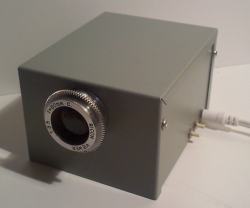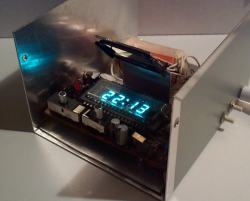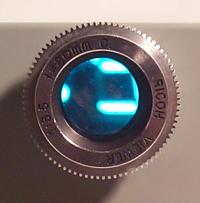
A Projection Clock
I'm pretty nearsighted and also an intermittent sleeper, and it has
always frustrated me to contort myself far enough to read my clock
radio display without my glasses on.
One could just move the clock radio really close, but why go for the
simple solution when a complicated one will do? I wanted a clock
like this for years.
To make one, you need the following main components:
- A small, bright light-emitting clock
- A front-silvered mirror
- A suitable lens
A suitable kind of clock is the vacuumfluorescent type that is found
in microwave ovens, VCRs and automobile dashboards. These are very bright
and seem to stay that way even when operated for many years. I found a
Radio Shack automotive clock/tach device for a dollar at a garage sale that was just
perfect for the job. The blinking colon would have been annoying but
I was able to fix that by grounding a pin on the display module.
 When the image is projected through the lens it ends up reversed, so to flip
it around again you need to reflect it in a mirror. A regular household
mirror has the reflecting material on the back, so you get a ghost reflection
from the front of the glass. For this project you need a front-silvered
mirror. I got mine out of a broken 35mm SLR camera, but a more likely
source is a broken laser printer, FAX machine or scanner.
When the image is projected through the lens it ends up reversed, so to flip
it around again you need to reflect it in a mirror. A regular household
mirror has the reflecting material on the back, so you get a ghost reflection
from the front of the glass. For this project you need a front-silvered
mirror. I got mine out of a broken 35mm SLR camera, but a more likely
source is a broken laser printer, FAX machine or scanner.
The lens may be the hardest part to find. Mine is an 80mm f/3.5 viewing lens
from a cheap old twin-lens reflex camera. It has a built-in focusing
mechanism, and projects an image about 1m across onto the wall from the
other side of the room. The next best thing would be a slide projector
lens which would give you a brighter but smaller image (typically they
are 100mm f/2.8.)
Construction is pretty simple, with bits of sheet metal and a lot of
epoxy glue. You can either build it very accurately, or you can bend
things around a lot until the projected image is level and has consistent
focus from corner to corner. I used the latter approach as you can
probably see from the picture of the guts.
 The whole thing is powered by a wall wart. The two pushbuttons are
connected to the clock setting contacts. The box is a generic metal
project box, with the hole for the lens gouged out by a rasp bit on a
dremel tool. The threaded ring that the lens screws into is glued onto
the inside of the lid with epoxy.
The whole thing is powered by a wall wart. The two pushbuttons are
connected to the clock setting contacts. The box is a generic metal
project box, with the hole for the lens gouged out by a rasp bit on a
dremel tool. The threaded ring that the lens screws into is glued onto
the inside of the lid with epoxy.
The focusing range is the same as that of the camera was, about 1m to
infinity. I have the clock on top of my bookshelf, aimed down at the
white wall just over my bed. The resulting display is large enough to
read easily without glasses on, and just bright enough. When it gets
light enough outside to make it unreadable, I shouldn't be in bed
anyway.
A perfect project for a junk and garage sale hound. I can't imagine
where you'd go to buy the necessary components new.
Update: February 1, 2001
You can get a projection clock at Radio Shack,
product number 630-0969. I'd give the URL that looks it up on
their site but it's horrendously long and unlikely to be valid for
very long. However typing the product number into the search box
will find it right away.
I bought this clock for my parents for Christmas, and I like it.
If it was available back in 1998 and if I had known about it, I probably
wouldn't have bothered building mine. It projects a sharp red display.
The projected display is only about a foot across when projected from
4 metres away, not huge like mine, but in return it is brighter.
The clock makes an impression of good quality. There are only two things
wrong with it: The "AM" or "PM" display above the projected time is
huge, out of proportion with the numbers, and the green backlight for
the nice LCD display on the clock itself cannot be set to stay on,
even when the clock is plugged into the wall -- you have to press
the snooze button to light it for 5 seconds or so.
Back to my projects page
 When the image is projected through the lens it ends up reversed, so to flip
it around again you need to reflect it in a mirror. A regular household
mirror has the reflecting material on the back, so you get a ghost reflection
from the front of the glass. For this project you need a front-silvered
mirror. I got mine out of a broken 35mm SLR camera, but a more likely
source is a broken laser printer, FAX machine or scanner.
When the image is projected through the lens it ends up reversed, so to flip
it around again you need to reflect it in a mirror. A regular household
mirror has the reflecting material on the back, so you get a ghost reflection
from the front of the glass. For this project you need a front-silvered
mirror. I got mine out of a broken 35mm SLR camera, but a more likely
source is a broken laser printer, FAX machine or scanner.
